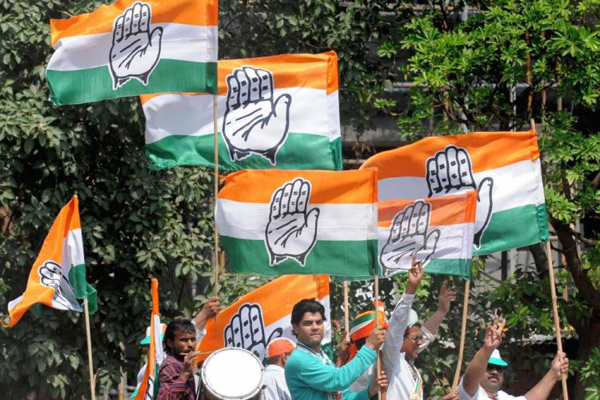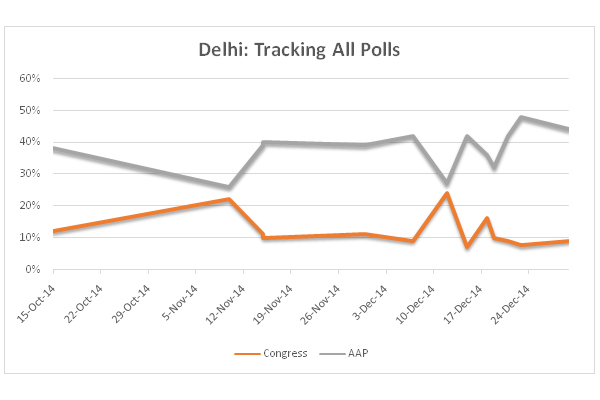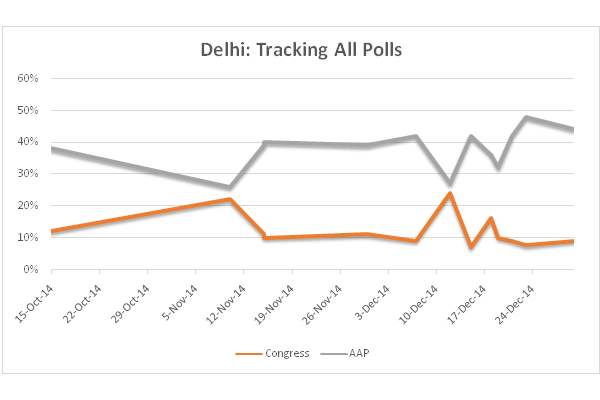
All opinion polls suggest that the main contest is between BJP and AAP, and for all practical reasons the Delhi contest has become bipolar. Congress is probably crashing out of the race. But a week is a really long time in politics. Keeping in mind the change in the vote composition of AAP in the last one year, the contest in Delhi is really interesting.
In December 2013, the BJP and AAP were contesting each other to get the anti-Congress votes. In other words, the anti-Congress votes got divided between AAP and BJP. It might sound weird, but if the Congress had retained its “core” 25% votes, and keeping in mind the acute anti-incumbency sentiment against the UPA central government (not to forget that Shiela Dikshit was CM for 15 years) this 25% “core” vote was not bad at all. Had the UPA2 baggage not been there and had Dikshit polled just about 3% more votes, then she might have been in her fourth term right now. That’s the First-Past-The-Post (FPTP) system for you.
Meanwhile, the AAP juggernaut caught the middle class imagination in NCR Delhi. The CVoter Poll for India Today in February 2014 revealed that in the event of a snap poll, the Kejriwal led party will sweep Delhi. The anti-Congress middle class seemed to have left BJP at state level and became the “core” vote bank of AAP. It is important to note here that in the same survey we also reported the “split” vote of middle class, where the same voter was supporting Modi as PM candidate and Kejriwal as CM candidate.
But, things started changing in March, when all of a sudden, AAP left the anti-Congress campaign and converted itself into anti-BJP campaign. The moment Kejriwal left Delhi for Varanasi and contested against Narendra Modi, it changed the entire paradigm in Delhi vote composition. The middle-class left AAP and rallied for Modi, resulting in more than 10% positive swing for BJP and a 7-0 sweep for Modi.
The AAP vote share went up between December Assembly elections and May Lok Sabha elections. By this time, the AAP vote composition had changed for good. Understanding that AAP is the main rival to BJP in Delhi, the “core” vote of Congress deserted the party in order to defeat Modi. Within 6 months, the AAP “core” vote transformed from anti-Congress to anti-BJP vote bank.
After May, this process actually went further. With Modi becoming the PM, the middle class remained with BJP. This point is well supported by all the opinion polls in last 6 months where the BJP vote estimate has remained between 40 to 45% approximately and almost all of them coming from the middle class voters. In other words, whatever the “others” had in terms of anti-Congress vote bank virtually shifted to BJP in May and has remained there for good all these months.
However, the interesting trend was the upswing or downswing of AAP and Congress vote bank and their relationship. While there is no doubt that the Kejriwal campaign against Modi has helped him further consolidate the anti-BJP voters, the fact remains that the see-saw of vote swing in Delhi is now between AAP and Congress with Modi holding on to the pole position.

When we plotted a graph of all opinion polls carried out by all agencies in last 3 months, the comparison of AAP and Congress vote estimates are concrete evidence that they are now contesting for the same “core” vote in the national capital. In every timeline of the opinion poll, the moment Congress support base goes up, the AAP support comes down. The moment AAP vote base goes up; the Congress support comes down crashing.

This is an empirical evidence which explains a lot of campaigning themes. The AAP campaign is now getting more focused on the “failures” of Modi government. The constant assertion from Kejriwal that “communalism is a bigger threat than corruption” aims at consolidating the anti-Modi votes. The relationship of AAP and Congress graph explains that even though on face value the contest looks like between BJP and AAP in Delhi; the real contest is actually happening between AAP and Congress for this “core” vote bank. If AAP graph increases, then Congress will be wiped out from the scene altogether. However if the Congress runs a spirited campaign, then the AAP votes will get down.
In the end, it will be the gap between BJP and the AAP that will reflect in the final seats tally of Delhi. The BJP votes remain above 40% and Modi has not even started the campaign in Delhi. It’s no more a question of divided opposition from the Congress perspective. It’s now a question of divided opposition from BJP perspective.